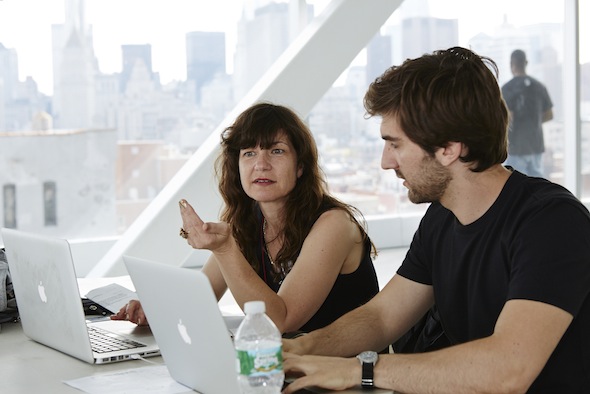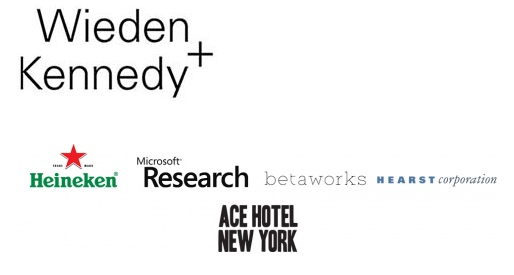
Organized by Michael Connor and Heather Corcoran, this edition of Seven on Seven was held on May 3, 2014 at the New Museum. Read Connor's seven take-aways from the program, Molly Osberg's deep-dive for the Verge, or Dawn Chan on the program for Vogue.
Keynote: Kate Crawford
Kate Crawford is a Principal Researcher at Microsoft Research, a Visiting Professor at the MIT Center for Civic Media and a Senior Fellow at NYU’s Information Law Institute. She researches social, political and cultural practices with media technologies. Her current project is focused on the politics and ethics of big data, for which she recently received a Rockefeller Foundation Bellagio Fellowship.
Holly Herndon & Kate Ray
Holly Herndon is an artist currently based in San Francisco, California. As well as touring the world to perform and exhibit new work, she is currently candidate for doctoral study in Computer Music at Stanford University. She received her MFA in Electronic Music and Recording Media at Mills College under the guidance of John Bischoff, James Fei, Maggi Payne, and Fred Frith. While at Mills she won the Elizabeth Mills Crothers Award for Best Composer in 2010 for her vocal generated piece 195.
Kate Ray founded Scroll Kit, an intuitive web creation tool that allows those who lack coding knowledge to tell powerful visual stories online. She also created Alongside.co, a visualization of your relationships based on Foursquare check-ins. She wants more people to cry in front of their computer screens and builds technology that helps people connect with each other and express themselves.
Aza Raskin & Kari Altmann
Aza Raskin is an interface designer and the Vice President of Jawbone, a San Francisco-based company that creates and sells wearable technology and portable devices. Originally from California, Raskin gave his first talk on user interfaces at the age of 10. He is founder of the music streaming community Songza, and has developed various projects for the Mozilla Corporation. He holds a double degree in mathematics and physics from the University of Chicago. His other projects include Massive Health, Algorithm Ink, and Bloxes, a cardboard furniture startup that was acquired by Amazon.
Kari Altmann is an artist focused on cultural technology, aggregation, and mistranslation as they relate to all mediums, from images to social networks to sculptures and back again. She is one of the most influential artists in the currently titled ‘post-internet’ canon. Recent features include a solo online exhibition, Soft Mobility Abstracts, for the New Museum, the Art Post Internet survey at Ullens Center in Beijing, and Brands: Concept, Affect, Modularity at Salts Center in Basel, for which her work was a starting point. She has done projects for and with Art Dubai, The Goethe Institute, the New Museum, Fade2Mind, Rhizome, The Hirshhorn Museum, Mixpak, Gentili Apri, DIS Magazine, Nero Magazine.
Hannah Sawtell & Avi Flombaum
Hannah Sawtell is an artist who lives and works in London. She has worked with video, digital image, sculptural installation, printed matter, industrial design, performance and noise. In 2012, Sawtell’s linked solo exhibitions, Osculator at the ICA and Vendor at Bloomberg Space, London, considered new technologies of accumulated surplus, valorization and access. Other solo shows include Vilma Gold, London and Clocktower Gallery, New York.
Avi Flombaum is founder of the Flatiron School. His career began at 16 when he worked for an NYC startup, cityfeet.com. At 20, he was the CTO of a hedgefund. Then he started a site called designer-pages.com. He organizes one of the largest Rails meetups in the world, NYC on Rails. Over the past few years, he’s taught Ruby to over 500 people, and loves sharing his passion for code with people.
Simon Denny & Nick Bilton
Simon Denny is a New Zealand artist currently based in Berlin, where his work explores the culture surrounding internet technology firms, neoliberal corporate culture and constructions of national identity. In 2012 he was nominated for the Walters Prize and also won the Baloise Art Prize at Art Basel for his Channel Document project. This year he exhibited The Personal Effects of Kim Dotcom at MUMOK, Vienna and presented All you need is data: the DLD 2012 Conference REDUX rerun at Kunstverein Munich, Petzel Gallery, New York and Hamburger Bahnhof, Berlin. He will represent New Zealand in the 2015 Venice Biennale.
Nick Bilton is a journalist and author. He is a columnist and reporter for The New York Times and leads The Times Bits blog. He has published two critically acclaimed books. His second book, Hatching Twitter, chronicles the relationship of the four creators of Twitter during inception, development and rise to prominence. The book was a New York Times bestseller and was voted Readers’ Choice Book of the Year by The Wall Street Journal. Hatch- ing Twitter is presently being turned into a TV series after being acquired by Lionsgate. Bilton’s work has been featured in Wired, Engadget, Scientific America, CNet, BBC, Guardian, and others. He has acted as an adjunct professor at New York University’s ITP and helped co-found NYC Resistor in Brooklyn.
Jen Fong-Adwent & Ian Cheng
Jen Fong-Adwent is a coder inspired by the idea of decentralizing the micro-blog. She created Meatspace Chat and has been developing it as an open source project with multiple contributors. Meatspace Chat is a web service where a user can generate a gif of and allows them to post an update with it in 250 words or less. The Meatspace realm also encompasses Aux, a Youtube and Vimeo video sharing cloud, and Meatspace TV, where users can host their own channel and create GIF shows for an online audience of other members. She also was involved in creating crypt-based message distributor Lexicrypt along with database and authentication-free hosting server The Great Brain. She currently works for Mozilla.
Ian Cheng is an artist based in New York. Recent solo exhibitions include La Triennale di Milano, Milan; Baby feat. Bali, Standard (Oslo), Oslo; Frieze Frame, London; Entropy Wrangler, Off Vendome, Dusseldorf; This Papaya Tastes Perfect, Formalist Sidewalk Poetry Club, Miami Beach. Recent group exhibitions include 12th Lyon Biennial, Lyon; Freak Out, Greene Naftali Gallery, New York; ProBio, Expo1, MoMA PS1, New York; DisImages, DIS Magazine, New York; A Disagreeable Object, Sculpture Center, New York.
Frances Stark & David Kravitz
Frances Stark is a Los Angeles-based artist working in multiple media—from works on paper to performance—examining “the conditions of creative labor,” and highlighting the aspects of artistic production that are less frequently acknowledged. Stark’s work has been exhibited extensively, including in solo shows at MoMA PS1 and the Van Abbemuseum in Eindoven, as well as notable group exhibitions such as the 2008 Whitney Biennial and the 54th Venice Biennale in 2011. In 2011, she was also commissioned to create a new work for Performa 11. She received her M.F.A. in 1993 from Art Center College of Design.
David Kravitz is a software engineer and one of the first developers behind the photo-messaging app Snapchat. He almost has a degree in computer science from Stanford University (just 3 credits left). When he’s not working on Snapchat, you can find him playing jazz piano and writing comedy. He currently resides in Los Angeles, California.
See their project in archival form: Opening the Kimono
Anil Dash & Kevin McCoy
Anil Dash is a New York-based entrepreneur and long-time blogger. He founded ThinkUp, a service that helps people get more meaning out of the time they spend on social networks. He is also co-founded Activate, a consultancy that helps companies strategize at the intersection of technology and media. Dash serves on the board of Stack Exchange, Data & Society, and the New York Tech Meetup.
Kevin McCoy is an artist working and exhibiting internationally with his partner Jennifer McCoy. His artworks explore changing conditions around social roles, categories, genres and forms of value. His work has adopted many methodological approaches: exhaustive categorization, recreation and reenactment, automation, miniaturization, and most recently, remote viewing and speculative modeling. His artwork is represented by in New York by Postmasters Gallery and in Geneva by Gallerie Guy Bartschi, and can be seen in the collections of the Museum of Modern Art, The Metropolitan Museum of Art, the Milwaukee Art Museum, and MUDAM in Luxembourg. He is an Associate Professor in the Department of Art and Art Professions at NYU.
See their project: Monegraph
Partners


